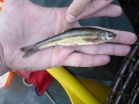The research also showed that yellow perch don't adjust spawning to match earlier spring-like temperatures. This poses a problem if the hatchlings' main food source, zooplankton, does make a temperature-based adjustment because supplies may be low by the time larvae are ready to feed.
"If not enough food is available, the larvae will grow slowly and be vulnerable to predators like invasive white perch," said Stuart Ludsin, principal investigator of the study and an associate professor of evolution, ecology and organismal biology at The Ohio State University.
On average, eggs produced in long, cold winter conditions in a lab experiment were 30 to 40 percent larger and their hatching success was between two- and four-fold better than the smaller eggs produced under warm, short winter conditions.
The survival problem could help explain why yellow perch numbers in Lake Erie have been low since 2003, and stand at only about half of the average fish population recorded during its heyday in the 1960s and '70s.
"There are a lot of factors that can help explain why yellow perch numbers are low in Lake Erie. The warmer winter temperature clearly is an important one," said Ludsin, also co-director of Ohio State's Aquatic Ecology Laboratory. "For management agencies, there is no easy fix to this problem."`
The study is published in the journal Nature Communications.
Ludsin first saw a relationship between warmer winters and reductions in the annual abundance of juvenile yellow perch in Lake Erie while working on his dissertation at Ohio State more than 15 years ago. He has spent much of his career working with Lake Erie fishery managers to try to explain why yellow perch numbers have fluctuated so dramatically over the past four decades.
For this study, the researchers combined long-term fisheries assessment data, a lab experiment and fieldwork to gauge the effects of warmer winters on one of Lake Erie's most popular fish among commercial and recreational anglers.
Yellow perch live on the bottom of Lake Erie, where water temperatures are about 40 degrees Fahrenheit (4 degrees Celsius) during the winter, said lead author Troy Farmer, a postdoctoral fellow at Auburn University who completed this work as a graduate student at Ohio State.
The scientists collected wild yellow perch from the lake with the help of state and federal biologists. In the lab, the scientists exposed different groups of fish to historic cold winter conditions or to warmer temperatures that have been recorded in more recent years.
Farmer said a long winter in the lab featured 107 days of water temperatures below 42 degrees Fahrenheit (5 degrees Celsius), which represented the average winter duration over the past 25 years. Under short winter conditions in the lab, the temperature remained under 42 degrees Fahrenheit for only 52 days, mimicking the length of the winter recorded in 1999.
"Our temperature treatments represented environmentally relevant conditions that are already being experienced by fish populations in Lake Erie," Farmer said.
Females exposed to warm, short winter conditions produced just as many eggs as their counterparts experiencing a long winter, but egg quality differed: They were smaller and didn't hatch as well, and eggs that did hatch produced unusually small larvae.
Yellow perch also don't show signs of adapting to warmer temperatures by fully adjusting when they spawn, Ludsin said. In both the lab and the field, the researchers observed that females continued to spawn in the historically typical months of April and May even when air temperatures reached the 80s in March in 2012.
"In lots of cold-blooded species, we find that as spring occurs earlier, the timing of reproduction will also move forward," Ludsin said. "Walleye are a great example. In the record short winter of 2012, walleye moved their spawning period up by several weeks. With yellow perch, we didn't see that."
The supply of zooplankton that yellow perch larvae eat can peak early along with warm weather. If food is scarce at the time eggs hatch, larvae will grow slowly and remain vulnerable to invasive white perch, a key predator in Lake Erie.
"If we didn't have that predator in the lake, the larvae that actually hatch after a warm winter might be able to survive just fine. But having short winters lead to low-quality larvae is a big disadvantage because of the risk of getting eaten," Ludsin said.
The research doesn't explain the biological mechanisms behind these reproduction problems for yellow perch.
"Yellow perch might have an inability to adjust their spawning to take advantage of those warm temperatures when they occur," he said. "Is there something hard-wired in them, like some physiological limitation, or an effect of temperature on hormones? We just don't know.
"It could be that we'll have to wait for adaptation to occur because there is no obvious quick fix. And, other ongoing stressors like nutrient pollution that causes low-oxygen zones and harmful algal blooms in Lake Erie don't help the situation," Ludsin said.
Ludsin also is principal investigator on a state-funded study looking at potential human health concerns associated with eating yellow perch and walleye caught from areas of Lake Erie affected by harmful algal blooms.
INFORMATION:
The yellow perch study was funded by the Federal Aid in Sport Fish Restoration Program, administered jointly by the U.S. Fish and Wildlife Service and the Ohio Division of Wildlife, the Great Lakes Fishery Commission's Fishery Research Program, a Norman S. Baldwin Scholarship from the International Association for Great Lakes Research and a Presidential Fellowship from Ohio State.
The Ohio State research team also included co-authors Elizabeth Marschall, chair of evolution, ecology and organismal biology and co-adviser with Ludsin on Farmer's graduate work, and Konrad Dabrowski of the School of Environment and Natural Resources.
Contact: Stuart Ludsin, 614-292-1613; Ludsin.1@osu.edu (E-mail is the best way to reach Ludsin), or Troy Farmer, farmetm@auburn.edu
Written by Emily Caldwell, 614-292-8152; Caldwell.151@osu.edu
